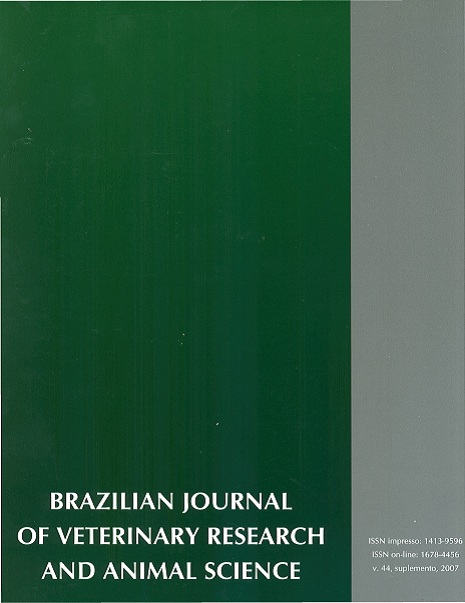Effects of several inspired oxygen fractions on the respiratory dynamics in spontaneously breathing dogs undergoing continuous infusion of propofol
DOI:
https://doi.org/10.11606/issn.1678-4456.bjvras.2007.26587Keywords:
Oxygen inspired fraction, Propofol, Dog, Respiratory parametersAbstract
The effects of several inspired oxygen fractions (FiO2) on the respiratory dynamics in spontaneously breathing dogs submitted to continuous infusion of propofol were evaluated. Eight adult mongrel dogs were used. Each animal underwent five anesthesias, in each procedure the patient was allowed to breath a different FiO2, thereby resulting in five groups, namely: G100 (FiO2 = 1), G80 (FiO2 = 0.8), G60 (FiO2 =0.6), G40 (FiO2 = 0.4), and G20 (FiO2 = 0.21). To induce anesthesia, propofol was given until the animals allowed orotracheal intubation, followed by immediate continuous infusion of drug. The initial measurement (M0) was recorded thirty minutes after the infusion of propofol has begun. Additional recordings were performed at 15 minute intervals for 60 minutes (M15, M30, M45 and M60). Numeric data were submitted to Analysis of Variance followed by Tukey Test (p<0.05). We recorded significantly lower values of SpO2 and SaO2 at G20, whereas PaO2 varied according to the changes in oxygen. Regarding PaCO2, the mean of G100 was greater than G20 at M30. However, spontaneously breathing dogs anesthetized with propofol at the rate of 0.7mg/kg/min should not be provided with 100%, 80%, and 21% oxygen owing to the significant compromise of respiratory system.Downloads
Download data is not yet available.
Downloads
Published
2007-12-03
Issue
Section
UNDEFINIED
License
The journal content is authorized under the Creative Commons BY-NC-SA license (summary of the license: https://
How to Cite
1.
Lopes PCF, Nunes N, Carareto R, Nishimori CTD, Paula DP de, Sousa MG, et al. Effects of several inspired oxygen fractions on the respiratory dynamics in spontaneously breathing dogs undergoing continuous infusion of propofol. Braz. J. Vet. Res. Anim. Sci. [Internet]. 2007 Dec. 3 [cited 2024 Apr. 25];44(supl.):30-7. Available from: https://www.revistas.usp.br/bjvras/article/view/26587





